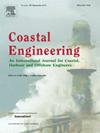Probabilistic estimation of the mean wave overtopping discharge on mound breakwaters
IF 4.5
2区 工程技术
Q1 ENGINEERING, CIVIL
引用次数: 0
Abstract
This study develops a probabilistic model, a Gaussian copula-based Bayesian Network (BN), to explain the joint probability distribution of the dimensionless mean wave overtopping discharge (, being the mean wave overtopping discharge, the gravity acceleration and the spectral significant wave height) and a set of explanatory variables on mound breakwaters. This model estimates the distribution of conditional to the values of (all or some of) the explanatory variables. The goal of this model is to allow the incorporation of the uncertainties of the structural response and the overtopping phenomenon to probabilistic frameworks. Given a tolerable value, a probability of failure can be directly computed from the distribution of estimated by the developed BN, differently to current methods in the literature which are deterministic. To develop the BN, a subset of CLASH database focused on mound breakwaters is used (3,179 tests), using 80% of those tests for training and 20% for statistical and performance testing. Ten dimensionless explanatory variables are selected with the following experimental ranges: bottom slope, ; wave attack angle, ; roughness factor, ; dimensionless crest freeboard, ; wave steepness, ; dimensionless width of the crest berm, ; dimensionless height of the crest berm, ; dimensionless width of the crest of the toe berm, ; dimensionless water depth at the toe of the structure, ; and armor slope, . Empirical cumulative distribution functions are used to quantify the nodes of the BN. The Gaussian copula assumption is successfully validated using the training subset. The proposed model is evaluated using the testing subset in both statistical and performance terms. In statistical terms, the proposed model seems to satisfactorily capture the dependence structure between the studied variables. In performance terms, the predicted mean of the distribution of is a reasonable estimator of () and the percentage of the observations that lay within the predicted 90% confidence intervals is close to the expected 90%. Finally, the use of the model for the probabilistic design of the crest elevation of mound breakwaters is also illustrated through one example. It should be noted that the less information provided to the model, the wider the estimated distribution of as the uncertainty is higher.
土墩式防波堤平均浪涌流量的概率估计
本文建立了一个概率模型,即基于高斯公式的贝叶斯网络(BN),来解释土墩防波堤上无量纲平均波浪过顶流量(Q= Q /gHm03,其中Q为平均波浪过顶流量,g为重力加速度,Hm0为谱有效波高)和一组解释变量的联合概率分布。该模型估计Q的分布以(全部或部分)解释变量的值为条件。该模型的目标是允许将结构响应的不确定性和过顶现象纳入概率框架。给定一个可容忍的Q值,可以直接从开发的BN估计的Q分布中计算故障概率,这与目前文献中确定的方法不同。为了开发BN,使用了侧重于土墩防波堤的CLASH数据库子集(3,179次测试),其中80%用于训练,20%用于统计和性能测试。选取10个无量纲解释变量,实验范围为:底部坡度7.6≤m≤1000;波浪攻角,0≤β≤80°;粗糙度系数,0.38≤γf≤1.00;无量纲波峰干舷,0≤Rc/Hm0≤4.37;波浪陡度,1.31⋅10−3≤s−1,0≤0.069;波峰堤无因次宽度,0≤Gc/Hm0≤6.67;无量纲堤高,0≤Ac/Hm0≤4.2;趾滩顶无因次宽度,0≤Bt/Hm0≤15.9;结构趾部无因次水深1.03≤h/Hm0≤17.6;而护甲斜率,1.19≤cotα≤4。经验累积分布函数用于量化BN的节点。利用训练子集成功地验证了高斯copula假设。使用测试子集在统计和性能方面对所建议的模型进行评估。在统计方面,所提出的模型似乎令人满意地捕获了所研究变量之间的依赖结构。在性能方面,Q分布的预测平均值是Q的合理估计值(R2=0.78),位于预测的90%置信区间内的观测值的百分比接近预期的90%。最后,通过一个算例说明了该模型在土墩式防波堤波峰高程概率设计中的应用。需要注意的是,提供给模型的信息越少,由于不确定性越高,估计的Q分布越广。
本文章由计算机程序翻译,如有差异,请以英文原文为准。
求助全文
约1分钟内获得全文
求助全文
来源期刊

Coastal Engineering
工程技术-工程:大洋
CiteScore
9.20
自引率
13.60%
发文量
0
审稿时长
3.5 months
期刊介绍:
Coastal Engineering is an international medium for coastal engineers and scientists. Combining practical applications with modern technological and scientific approaches, such as mathematical and numerical modelling, laboratory and field observations and experiments, it publishes fundamental studies as well as case studies on the following aspects of coastal, harbour and offshore engineering: waves, currents and sediment transport; coastal, estuarine and offshore morphology; technical and functional design of coastal and harbour structures; morphological and environmental impact of coastal, harbour and offshore structures.
 求助内容:
求助内容: 应助结果提醒方式:
应助结果提醒方式:


